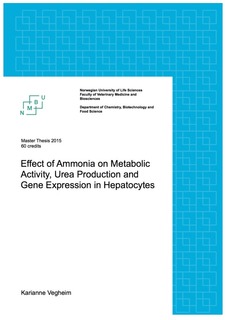| dc.description.abstract | Background: The key organ for ammonia detoxification is the liver, predominantly via urea cycle and glutamate-glutamine cycle. In patients with acute and chronic liver failure, hyperammonemia often occur as a secondary condition. Elevated blood ammonia levels give arise to increased ammonia concentration in the brain, which can result in hepatic encephalopathy and hepatic coma. While the neurotoxic effects of increased ammonia have been emphasized, the potential hepatotoxic effects of ammonia have been less studied. However, there are some reports of histopathological changes in the liver of patients with urea cycle defects. These patients have often repeatedly been exposed to high ammonium levels and this indicates that ammonia may affect the liver as well. Aims: The purpose was to examine how ammonia affects hepatocytes, considering hepatocyte viability, urea production, and expression of selected genes including hepatobiliary transport systems, aquaporins, and nuclear receptors.
Methods: In vitro cell culture of Hep G2 (hepatocellular carcinoma) and H1 cells (human embryonic stem cell line differentiated into derived hepatocyte-like-cells) were used in the experiments. Cell damage and metabolic activity were assessed with aspartate aminotransferase (AST) measurement and MTT assay, respectively. Gene expression analysis was assessed with quantitative RT-PCR, and western blotting was used for protein quantification. Urea production after exposure to ammonium chloride was measured in supernatant in both cell lines. Further, RNA interference (siRNA) experiments were performed to examine whether FXR was involved in regulation of some selected genes. Results and conclusion: We demonstrate that ammonium reduces metabolic activity in Hep G2 cells by MTT assay. In H1 cells ammonium chloride caused increased levels of AST. A dose-dependent increase in urea production after exposure to ammonium chloride was found in both cell lines. Ammonia increased the expression of AQP8 mRNA. Increased levels of OATP1 were also found in both cell lines, in addition to increased levels of AQP9 in Hep G2. After knockdown of FXR, AQP8 was unaffected, indicating that FXR did not have an important role in regulation of AQP8. AQP8 protein levels were not increased after exposure to ammonia. Ammonia affects cell damage and metabolic activity in H1 and Hep G2 cells, respectively, and causes changes in expression of some genes in hepatocytes. | nb_NO |
